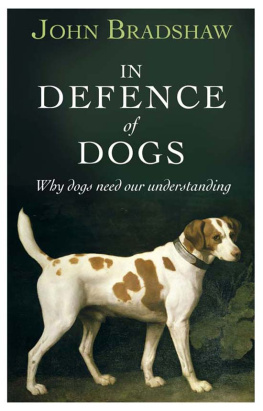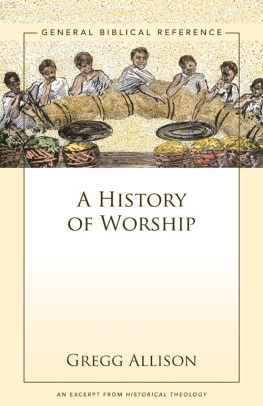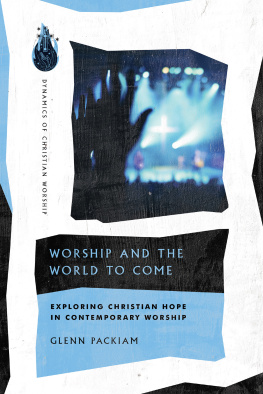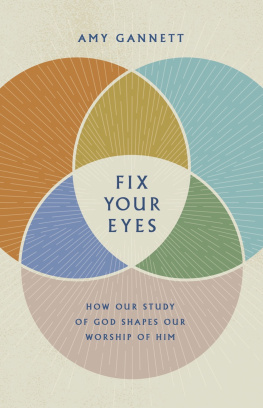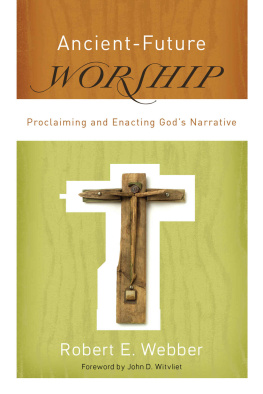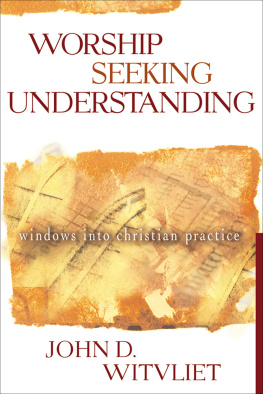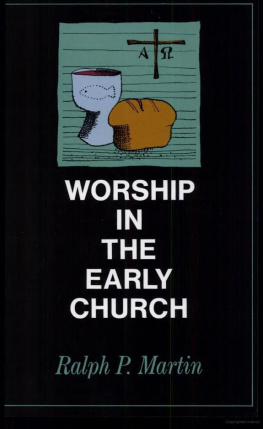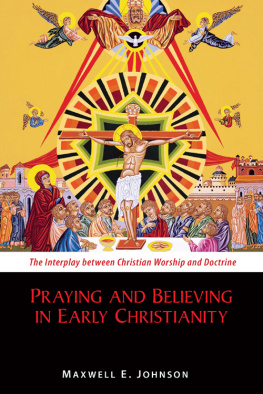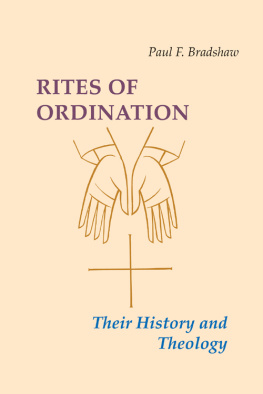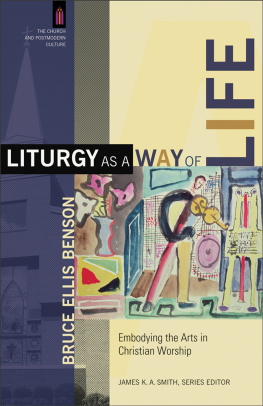Paul Bradshaw is Professor of Liturgy at the University of Notre Dame, USA, an honorary canon of the Episcopal Diocese of Northern Indiana, a priest-vicar of Westminster Abbey and a member of the Church of England Liturgical Commission. A former president of the North American Academy of Liturgy and of the international Societas Liturgica, as well as editor-in-chief of the journal Studia Liturgica from 1987 to 2005, he has written or edited over 20 books. Among them are The Search for the Origins of Christian Worship (2nd edn, SPCK, London/OUP, New York 2002) and Reconstructing Early Christian Worship (SPCK, London 2009).
EARLY CHRISTIAN WORSHIP
A basic introduction to ideas and practice
Second edition
PAUL BRADSHAW

First published in Great Britain in 1996
Society for Promoting Christian Knowledge
36 Causton Street
London SW1P 4ST
www.spckpublishing.co.uk
Reprinted twice
Second edition published 2010
Copyright Paul Bradshaw 1996, 2010
All rights reserved. No part of this book may be reproduced or transmitted in any form or by any means, electronic or mechanical, including photocopying, recording, or by any information storage and retrieval system, without permission in writing from the publisher.
SPCK does not necessarily endorse the individual views contained in its publications.
Unless otherwise noted, Scripture quotations are taken from the Revised Standard Version of the Bible, copyright 1946, 1952 and 1971 by the Division of Christian Education of the National Council of the Churches of Christ in the USA. Used by permission. All rights reserved. NB The RSV Apocrypha was copyright 1957.
British Library Cataloguing-in-Publication Data
A catalogue record for this book is available from the British Library
ISBN 978-0-281-06345-1
E-ISBN 978-0-281-06488-5
1 3 5 7 9 10 8 6 4 2
Typeset and eBook by Graphicraft Limited, Hong Kong
Contents
Where some of the following translations of ancient writings use non-inclusive language with regard to human beings, they have been amended in the extracts cited in this book. Any translations not otherwise attributed are the work of the author.
AIR | Edward Yarnold, The Awe-Inspiring Rites of Initiation , 2nd edition. Copyright 1994 T & T Clark, Edinburgh. |
DBL | E. C. Whitaker, ed., Documents of the Baptismal Liturgy , revised and expanded by Maxwell E. Johnson. Copyright 2003 SPCK, London. Extracts reprinted with permission. |
PEER | R. C. D. Jasper and G. J. Cuming, eds, Prayers of the Eucharist: Early and Reformed , 3rd edition. Copyright 1987 by The Order of Saint Benedict, Inc. Published by Liturgical Press, Collegeville, Minnesota. Reprinted with permission. |
It is a sign of the extent of the continuing research that has taken place into the history of early Christian worship by myself and others in the 15 years since I originally wrote this book that scarcely any chapter has been left unchanged in this revised edition. Although in some cases the adjustments have been relatively minor, in others extensive rewriting has had to be done, so differently do many scholars now interpret the evidence that was presented there.
Originally commissioned as an undergraduate textbook for the University of South Africa and then offered to a wider audience, this little work aims not merely to describe what rites Christians performed during the first few centuries of the Churchs existence but also to explain why they did them: What caused them to choose those particular liturgical forms instead of others? What did they understand themselves to be doing in their worship? What effect did that have on the development of Christian doctrine? And how did new doctrinal formulations in turn affect the character of the rites? If readers keep these questions in mind as they go through each chapter, they should have little difficulty in finding the answers in the text.
In such a small volume it has not been possible to deal with the subject in great detail, but suggestions are included for further reading for those who wish to go further, and more extensive background to the sources and methods used in the study of early Christian liturgy can be found in the second edition of my book, The Search for the Origins of Christian Worship (SPCK, London, and Oxford University Press, New York 2002).
Paul Bradshaw
In this section we shall first examine the roots of Christian baptismal thought and practice in New Testament times, and then see how different elements of this were picked up and developed in various early Christian traditions, concentrating principally on the contrasts between Syria and North Africa, before going on to look at the movement towards a more common baptismal theology and liturgy in the fourth century. We shall end our survey by considering the effects that the later spread of infant baptism had on both the practice and understanding of Christian initiation.
Suggestions for further reading
In addition to works cited in notes, the following are recommended:
Paul F. Bradshaw, Reconstructing Early Christian Worship (SPCK, London 2009), chapters 46.
Maxwell E. Johnson, The Rites of Christian Initiation (2nd edn, Liturgical Press, Collegeville 2007), chapters 15.
Bryan D. Spinks, Early and Medieval Rituals and Theologies of Baptism (Ashgate, Aldershot 2006), chapters 13.
Jesus apparently did not leave his followers with a fixed set of doctrines but rather with an experience that changed their lives, which they then tried to articulate in their own ways. As a result, what we find in the New Testament is not one standard theology of baptism or a systematized explanation of what it means to become a Christian, but a variety of ways of speaking about that experience, quite different images and metaphors being employed by different writers in their attempts to communicate it to others.
Antecedents
The New Testament implies that the custom of baptizing those who were converted to the Christian faith was derived from John the Baptist (see, for example, Matthew 3.112), but the source of his own practice is uncertain. Some scholars have argued that it was based on the ablutions of the Jewish Essene community at Qumran, but these were repeated washings related to the need for constant ritual purity and do not seem to have included an initiatory baptism. Others have suggested that John was influenced by the practice of baptizing new converts to Judaism, but there is some doubt whether this was being done in his time or whether it was only adopted at a later date. A third possibility is that it arose out of the Israelite traditions of ritual purification (see, for example, Leviticus 15.513) and/or of prophetic symbolism, which had spoken of Gods people being cleansed with pure water in preparation for the advent of the messianic age (see, for example, Ezekiel 36.28).
Whether the Christian adoption of baptism began with Jesus himself or only in the Church after his resurrection cannot easily be resolved. All three synoptic Gospels record Jesus own baptism by John but say nothing of him baptizing his followers. The Gospel of John, on the other hand, does not mention Jesus being baptized but does speak of him baptizing others (John 3.22, 26; 4.1; but cf. 4.2). Matthew 28.1920 contains a command to baptize all nations, but there are difficulties in accepting this as an authentic saying of the risen Lord.




